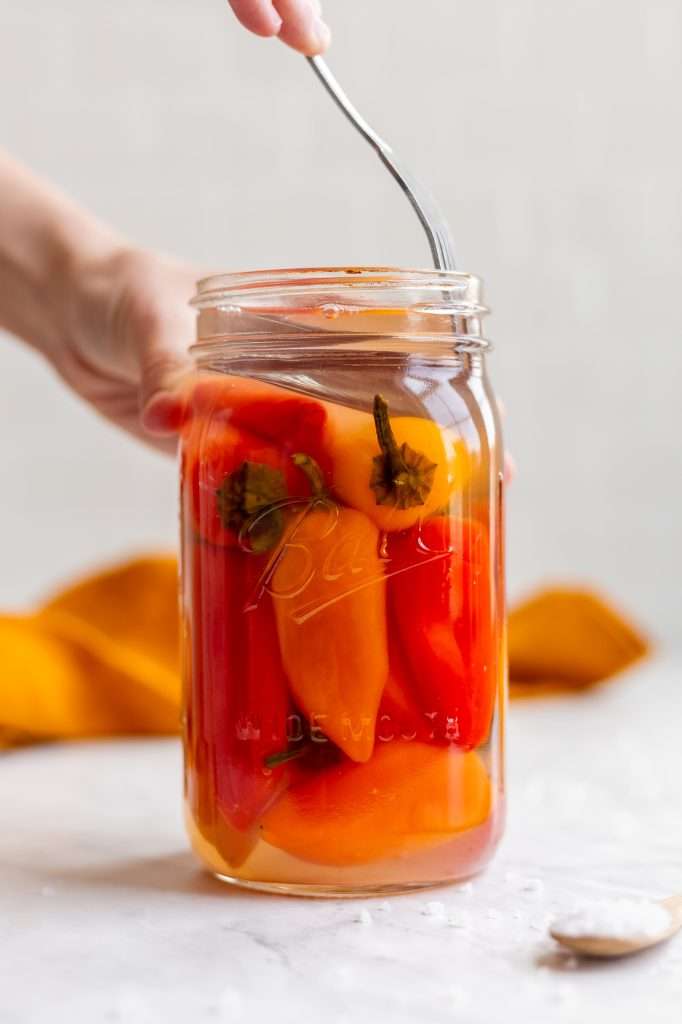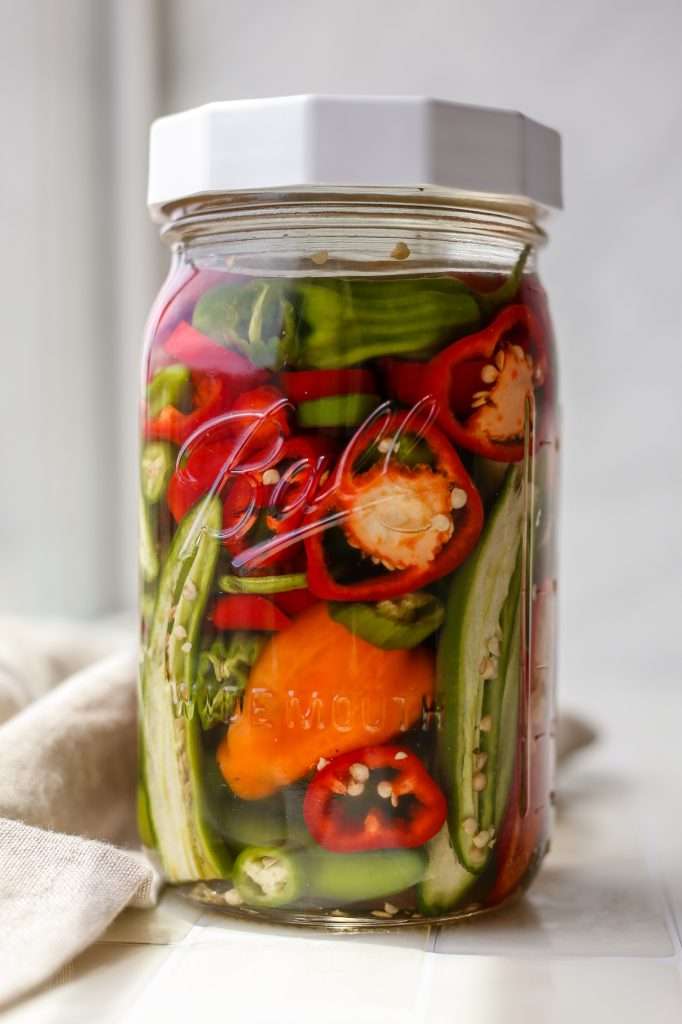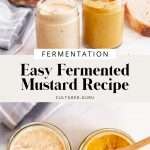Easy Fermented Mustard
The way we make fermented mustard is different from vegetable fermentation processes. Since mustard seeds are a dry good, they need to be fermented differently to ensure a safe, preserved product.
For this recipe we used already acidified, probiotic sauerkraut brine in addition to vinegar to create probiotic mustard.
When I make mustard from scratch, I always let it ferment and age for about a month. The aging process helps to reduce the initial bitter flavor. Mustard seeds and mustard powders are initially very bitter, but with time, the bitterness dissipates.

Ingredients For Mustard Fermentation
- Mustard Seeds and Mustard Powder: This is the main ingredient in mustard. I like to use a mix of brown and yellow mustard seeds with yellow mustard powder. In this fermented mustard recipe you have the option of blending it for smooth mustard or keeping it course.
- Vinegar: Any vinegar will work here. I think white vinegar or apple cider vinegar give the best flavor. You can also use rice vinegar.
- Sauerkraut Brine: for this, you use the brine from homemade sauerkraut
- Sea Salt: As always, I suggest using unrefined sea salt. Any type of unrefined sea salt works well.
- Horseradish: I LOVE horseradish in mustard recipes. I think the flavor pairs so well with mustard seeds. You can use horseradish powder, but I suggest using the prepared horseradish found in a jar in the refrigerated section of the store.
- Honey or Maple Syrup: Most mustard recipes call for a type of sweetener, usually sugar. I prefer to use honey or 100% pure maple syrup instead of sugar.
- Spices: This recipe requires Garlic, Onion, Tarragon, Cinnamon, and Turmeric. Which spices you use depends on the type of mustard you want to make.


Fermented Mustard Seeds
I prefer my mustard to be lacto-fermented for three main reasons.
The first being digestibility. Sometimes I like to go overboard with the mustard on burgers and sandwiches… and that sometimes results in a bit of indigestion. BUT when it’s fermented, I have no issues. So more mustard, fewer problems!
Next, I prefer the flavor. Mustard is a very flavorful condiment, but did you know that when it’s fermented the flavor is even better?
Lastly, I love making this fermented condiment because it’s easy to add some probiotic bacteria to any sandwich or burger.
Fermented Mustard Recipe
You’ll need to have sauerkraut brine ready for this recipe. You can make sauerkraut using our homemade kraut recipe. Other than that, you need a quality blender or food processor.


Fermented Mustard Recipe German and Traditional Versions
Learn all about mustard fermentation with our Easy Fermented Mustard Recipe. This recipe includes two options for flavoring fermented mustard seeds. Add this fermented mustard to sandwiches, burgers, wraps and salad dressings for probiotic benefits.
- Prep: 10 minutes
- Cook: 0 minutes
- Total Time: 10 minutes
Ingredients
Mustard Base Ingredients
- 50 Grams Yellow Mustard Seeds
- 50 Grams Brown Mustard Seeds
- 50 Grams Mustard Powder
- 50 Milliliters Sauerkraut Brine
- 75 Milliliters Vinegar*
- 50 Milliliters Filtered Water
- 12 Grams Sea Salt
- 2 Tablespoons Honey
- 1 Tablespoons Horseradish
Spices For German Mustard
- 1/8 Teaspoon Cinnamon, ground
- 1/4 Teaspoon Tarragon, ground
- 1/2 Teaspoon Garlic Powder
- 1/2 Teaspoon Onion Powder
Spices For Regular Mustard
- 1 Teaspoon Garlic Powder
- 1/4 Teaspoon Turmeric Powder
Instructions
- In a clean bowl, combine all of the mustard base ingredients. Stir until evenly combined.
- Choose which spices to use, either the combination for german mustard or the combination for regular mustard.
- Mix in the spices until evenly combined.
- Add the contents to a blender or food processor. For smooth mustard, blend until smooth. For course mustard, just pulse in the blender.
- Add the mustard mixture into a clean mason jar.
- Secure the lid and leave at room temperature for 48 hours.
- After 48 hours, stir the mustard, replace the lid, and store the jar in the fridge for 4 weeks. This is a slow cold fermentation, aka the aging process. This process will eliminate the initial bitter flavor of the mustard.
- After 4 weeks you can use the mustard on sandwiches, on burgers, in salad dressing recipes, etc.
- Store for up to 6 months in the fridge.
Notes
* you can use any vinegar, but I like the flavor of white vinegar best.




















Thanks for sharing! Can I freeze it?
I’ve never tried, but I think freezing it would be okay. Have you ever frozen mustard before?
Would omitting the horseradish cause any issues?
no it wouldn’t cause any issues, the flavor will just be a little different
thank you for the recipe! I was looking for some ingredients to the mustard of “insane in the brine”. will try your recipe. I only wonder which the ingredients of the german mustard makes you think of german food? Most types of mustard (unless bought in a special shop) here (in Germany) consist of only mustard (plus vinegar, salt, sugar), but nothing else.
You’re welcome. It’s not that any particular ingredient makes me think of German food… I just picked up some mustard labeled “German mustard” from the grocery store, read the ingredient label and then recreated it, but made my recipe fermented.
Thank you for the recipe. It is pretty close to what I was looking for. I have one question though: isn’t vinegar usually used to stop fermentation when you think it is ready? Doesn’t it cause any problems when you add it to the mash at the beginning? I am nee to fermenting, so I have no clue, I was just wondering.
You’re welcome! No, vinegar is fermented and doesn’t stop this type of fermentation. Raw Vinegar with the mother, like apple cider vinegar, contains live microbes, including some lactobacillus.
Thank you very much! I didn’t know that. There is so much contradicting information out there. But you obviously know your stuff, so I trust you. 😉
Can I substitute natural fermented pickle brine for the sauerkraut brine?
Wondering if you’ve ever added an IPA beer to the German mustard?
A relative / chef mentioned he made a fermented grainy mustard with addition of beer.
Any help or recipe would be greatly appreciated!😋
Hi Kaitlynn,
Thank you for the recipe. Sounds yummy. I have few questions.
Is Sauerkraut Brine absolutely needed? Can I make it without it?
You have all dry ingredients. Can I add raw garlic instead of powder?
I’ve only tested the recipe with sauerkraut brine, so I’m not sure how it will be without.